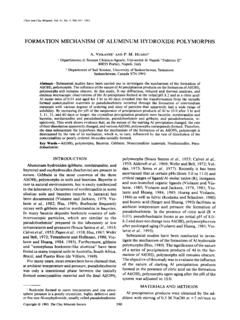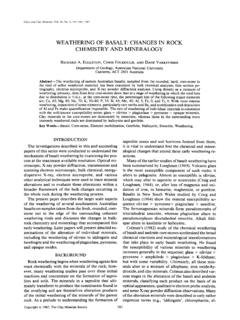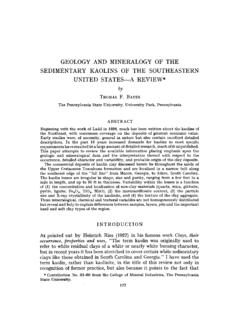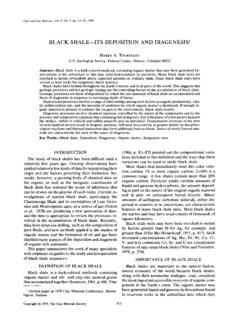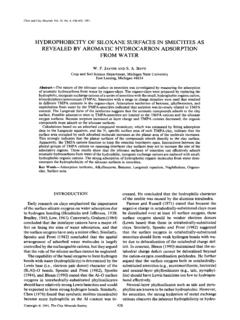Transcription of X-RAY DIFFRACTION PATTERNS OF MONTMORILLONITE …
1 Clays and Clay Minerals, Vol. 39, No. 6, 580-585, 1991. X-RAY DIFFRACTION PATTERNS OF MONTMORILLONITE oriented . FILMS exchanged with ENANTIOMERIC A N D RACEMIC. TRIS(2,2'-BIPYRIDYL) RUTHENIUM(II). GILLES VILLEMURE. Department of Chemistry, University of New Brunswick, Bag Service #45222, Fredericton New Brunswick E3B 6E2, Canada Abstract-- X-RAY DIFFRACTION PATTERNS of oriented films of montmorillonitecontainingenantiomeric tris(2,2'- bipyridyl) ruthenium(II) chloride (Ru(bpy)22 show a peak corresponding to basal spacings of approxi- mately 27 ,~. This peak is absent from the X-RAY PATTERNS of MONTMORILLONITE films containing racemic cations. A basal spacing of 27 ,~ is consistent with the adsorption of 2 layers of the enantiomeric cations in each interlayer space.)
2 Under the same condition only one layer of the raeemic cation was intercalated (basal spacings of A). These results are in accord with previous reports that MONTMORILLONITE can adsorb more of the optical isomers than of the racemic mixture of Ru(bpy)32+. Addition of NaC1 to the mixtures resulted in an increase in the level of adsorption of the racemic cations and in the appearance of a peak at 27 A in the X-RAY pattern. Key Words--Double layer, Enantiomorphs, Intercalation, Monolayer, MONTMORILLONITE , Surface area, Tris(2,2'-bipyridyl)ruthenium(II),X-rays . INTRODUCTION lemure and Bard (1990) proposed that adsorption of There is as yet no satisfactory explanation for the racemic Ru(bpy)32+ caused more extensive face-to-face ability of smectite clays to distinguish between the en- aggregation of the clay layers than adsorption of en- antiomers and the racemic mixture of tris(2,2'-bipyr- antiomeric Ru(bpy)32+.)
3 A difference in the clay mor- idyl)ruthenium(II) cations (Ru(bpy)31+) (Yamagishi, phology is consistent with the interpretation of the 1987). Because smectites are not optically active spectral differences in terms of more extensive inter- (Cairns-Smith, 1982), the source of the difference in calation of racemic than enantiomeric Ru(bpy)32+. sorption has been attributed to a packing phenomenon. (Thomas, 1988). More extensive intercalation of the Yamagishi (1987) proposed that the adsorption of racemic cations would also explain why each adsorbed Ru(bpy)32 by clay minerals occurred in racemic pairs, racemic Ru(bpy)32+ covers an average of 217 A2 of the which he assumed packed more efficiently than en- clay surface, compared to only 122 ,~2 for each ad- antiomeric pairs, making it possible to intercalate more sorbed enantiomeric Ru(bpy)32 (Villemure, 1990).
4 A n of the racemic mixture than of the enantiomers in the intercalated cation is in contact with two clay layers, space available between the clay layers. and is expected to cover approximately twice the area Aside from the fact that a more compact adsorption of an externally adsorbed cation. of the racemic cations has never been experimentally Differences in the clay aggregation should have an demonstrated, there are several problems with this hy- effect on its X-RAY DIFFRACTION pattern. The present study pothesis. First, it does not account for the differences was undertaken to test this hypothesis. seen at low loading levels. At small cation/clay ratios, differences are seen in the absorption and emission EXPERIMENTAL.
5 Spectra of adsorbed Ru(bpy)32 When the cation is The clay used was a sample of MONTMORILLONITE (SWy- highly diluted in the clay, packing efficiency should not 1), obtained from the Source Clay Minerals Repository matter. Yet, these differences increase with decrease of of The Clay Minerals Society (University of Missouri, the cation/clay ratio (Joshi and Ghosh, 1989). Second, Columbia, MO). Its sodium form was prepared and its the m a x i m u m amounts of racemic and enantiomeric < ~tm (esd) fraction separated by literature proce- cations adsorbed by smectites can differ by as much dures (Jackson et al., 1949). Its cation exchange ca- as a factor of (Villemure, 1990). How can small pacity (CEC) was meq/g 0 a y n e s and Bigham, differences in packing efficiency have such major effects 1986).
6 Ru(bpy)3C12 (Aldrich) was used without further on the adsorption isotherms? Furthermore, unlike what purification. Its enantiomers were separated as iodides, was reported for Ru(phen)32 (Yamagishi, 1985), it is by treatment with potassium antimonyl tartrate (Al- the enantiomers of Ru(bpy)32+ that were adsorbed in drich), according to the procedure of Dwyer and Gyar- larger a m o u n t s (Villemure, 1990). fas (1949). Measured values of [~]D were + 6 6 0 0 ~ for In an attempt to reconcile these observations with the A-isomer and --6500 ~ for the A-isomer. Compar- Yamagishi's racemic-pairs adsorption hypothesis, Vii- ison with literature values, + 7 1 9 4 ~ and - 7 1 8 4 ~ re- Copyright 9 1991, The Clay Minerals Society 580.
7 Vol. 39, No. 6, 1991 Racemic, A-, and A-Ru(bpy)3 z+ in MONTMORILLONITE films 581. spectively (Dwyer and Gyarfas, 1949), gives optical purities o f 96% for the A-isomer and 95% for the cm). 0" 9. A-isomer. The iodides were converted to the chlorides []. by stirring with AgC1. To measure the adsorption isostherms, volumes o f a clay suspension ( g/liter) were mixed with vol- o O. umes o f stock solutions ( m M ) o f A, A, or racemic Ru(bpy)32+. The initial cation concentration in the mixtures was increased from m M to mM, while the clay concentration was decreased from cc g/liter to g/liter, so that the cation/clay ratio in r the mixtures varied between approximately 30 and 500% o f the d a y ' s CEC. To ensure that each mixture [Ru(bpy~*] in solution (104mole/liter).
8 Contained at least 5 mg o f the clay, the total volume Figure 1. Adsorption isotherms ofracemic and enantiomer- o f the mixtures was gradually increased to compensate ic Ru(bpy)32 by suspensions of the < ~tm (esd) fraction for the decrease in the clay concentration. of Na+- MONTMORILLONITE , SWy-1. Diamonds, racemic mix- In all cases, flocculation o f the clay occurred soon ture; triangle, A-enantiomer; squares, A-enantiomer; the filled after the addition o f the cation. It was especially rapid symbols are the points that correspond to the X-RAY DIFFRACTION for the first few mixtures, where the clay concentrations PATTERNS shown in Figures 2, 3 and 4. were large. The flocs were larger in the mixtures con- taining the racemic cation, while they were smaller and more numerous in the mixtures containing the enan- enantiomers used in the present study.
9 A d s o r p t i o n iso- tiomers. After standing for 2 days, with only occasional therms measured after the optical purities o f the en- stirring, the mixtures were centrifuged, and the de- antiomers were increased to 99% by further recrystal- crease in concentration o f Ru(bpy)32 in the superna- lization o f the cations were similar to those in our tant determined by UV-visible spectroscopy (MLCT previous report. band, e = 14,600 M - ' cm -1 at 452 n m (Kalyanasun- Figure 2 shows the X-RAY DIFFRACTION PATTERNS o f ori- durum, 1982)). ented clay films that contained , , and The oriented films ( x cm) were prepared by meq/g o f adsorbed racemic, A- and A-Ru(bpy)32+, re- placing the clay sediments in small volumes o f the spectively; about I/3 o f the clay CEC.
10 F o r both enan- supernatant solutions (< ml) on microscope slides, tiomers, a very broad peak is seen at a 20 angle cor- and allowing the water to evaporate overnight. The responding to a basal spacing o f approximately 16/~. m i n i m u m thickness o f the films, estimated from the This peak is much sharper for the film containing the a m o u n t o f clay contained in each mixture ( > 5 rag), racemic cation. was o f the order of 3-4 #m. Note that, although several Figure 3 shows the X-RAY DIFFRACTION PATTERNS cor- o f the films were extensively cracked, they still gave responding to the 5 th points o f the adsorption isotherms good X-RAY PATTERNS . The X-RAY DIFFRACTION PATTERNS o f Figure 1. These films contain , , and were recorded by Mr.

